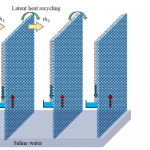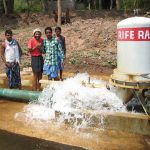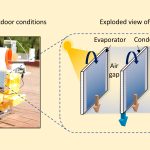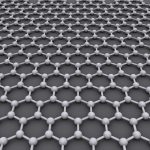Next-generation solar material offers promise in revolutionising renewable energy
(Photo courtesy: Laxman Gouda)
In 2021, a 7 MW ‘agro-photovoltaic’ solar plant was commissioned at Degaon village in the Dhule district of Maharashtra. What’s unusual about this plant is that agricultural crops grow amongst rows of solar panels that stretch over them like a canopy, saving a tremendous amount of land area and also providing electricity to the farmers. Unlike traditional solar projects that often displace farming communities, this project has been welcomed by the farmers and local residents. It is one of the 22 such agrivoltaic projects in India, where land is simultaneously used for agriculture and solar power generation.
At the COP26 summit in November 2022, India made a commitment to meet 50% of its energy requirements from renewable energy by 2030. An essential step to reaching this goal is the development of solar ‘farms’ that generate energy from sunlight using solar cells. Solar energy is the least expensive source of energy in most countries. However, building a traditional solar farm on arable land, where solar cells are kept in a tight array close to the ground, will make it unsuitable for crop cultivation. Agrivoltaic projects, on the other hand, have solar cells – usually made of silicon – that are spread apart and raised on stilts to ensure sufficient sunlight for the crops, and space to operate farm machinery. In some cases, the solar cells can also adjust the availability of sunlight for the crops by rotating about an axis – they can tilt horizontally to capture the maximum light, and vertically to allow the most light to fall on the crops. However, these modifications can greatly increase the installation costs. As an alternative, scientists (including those at IISc) are exploring the use of semi-transparent solar cells which allow part of the light to pass through them. To develop these cells, they are banking on a new class of materials called perovskites.
Lead-halide perovskites, in particular, show great promise for high-efficiency solar cells. Originally, the term ‘perovskite’ referred to the mineral Calcium Titanium Oxide (CaTiO3), but now it is used to refer to an entire family of materials that have the same crystal structure as CaTiO3, called the ABX3 structure. Here, ‘A’, ‘B’ and ‘X’ refer to different elements, with A being an organic cation (atom with a positive charge). In lead-halide perovskites, the element lead occupies the ‘B’ slot, and a halide such as fluorine or chlorine occupies the ‘X’ slot. “Perovskites have excellent properties. In terms of efficiency, they are competitive with silicon,” says Sushobhan Avasthi, Associate Professor at the Centre for Nano Science and Engineering (CeNSE), IISc.
Why perovskites are better
A typical solar cell consists of multiple layers. Of these, the ‘active layer’ is the one responsible for generating electrons that flow out of the solar cell as current. The active layer is made up of semiconducting materials. Light falling on the solar cell generates electron and hole pairs, which are the carriers of current. “If light particles that fall on the active layer have an energy lesser than the band gap, they cannot be absorbed,” explains Satish Patil, Professor at the Solid State and Structural Chemistry Unit (SSCU), IISc. “Moreover, there are several ‘loss mechanisms’ that happen after light is absorbed. This means that solar cells can never be 100% efficient.”
Sachin Rondiya, Assistant Professor in the Department of Materials Engineering, conducts research on energy materials and devices in his lab. He emphasises: “Technological improvements in perovskite solar cells (PSCs) are achievable through a deep understanding of design rules for the next-generation perovskite materials to tolerate defects and interface loss within these devices.” He underlines the industrial advantages of perovskite materials, made possible through “innovative materials engineering and structured integration with conventional silicon solar cells in a tandem configuration, resulting in more efficient light absorption than traditional solar cell technologies.”
“Perovskites can be deposited on various surfaces such as glass, plastic and steel with minimal effort while maintaining their efficiency. We don’t know of any other material that can do that,” says Sushobhan. PSCs are exceptionally defect-tolerant, which is to say that their performance is not drastically affected by imperfections in the material. This means that they can be manufactured quickly using low-cost methods, like solution processing.
In solution processing, the starting materials for a perovskite are dissolved in a solution that is deposited on the desired surface by one of several methods – spraying from a nozzle (spray coating), dipping the surface in a vat of solution (dip coating), dispensing on a spinning surface so that the solution spreads evenly (spin coating), or by inkjet printing similar to how a printer spits out ink on paper. The deposited solution is then allowed to evaporate, leaving behind a thin layer of perovskite. Solution processing can be done at room temperature and using fairly simple machines. Compare this with manufacturing silicon solar cells, which requires hundreds of hours inside highly controlled and sophisticated reactors at very high temperatures exceeding 1,500 °C. “India does not have the facilities to manufacture silicon solar cells/wafers, so we end up importing them from other countries like China,” explains Praveen Ramamurthy, Professor at the Department of Materials Engineering. Their ease of manufacturing, therefore, is the biggest advantage of PSCs.
Challenges to commercialisation
But this ease of manufacturing also leads to the biggest challenge in commercialising them – durability. “According to thermodynamics, what is easy to make is also easy to unmake. Thus, perovskite solar cells are unstable and degrade quickly and their efficiency drops drastically,” explains Sushobhan. But there are two ways to improve the stability of PSCs. “One is by changing the composition of the perovskites so that they are intrinsically more stable, and the other is to encapsulate the PSCs so that they are protected from oxygen and water,” he adds. The first method is one of the areas of research in Sushobhan’s lab. They have recently developed a new composition of a lead-halide perovskite that showed increased stability compared to the original composition – the new PSC retained 70% of its starting efficiency after 480 hours in ambient conditions, whereas the original PSC’s efficiency dropped to 43% in the same time.
Another challenge is scalability. When researchers report on the efficiency of solar cells, they are usually talking about a lab-scale solar cell, typically less than 1 cm2 in area. The same deposition techniques used to make lab-scale solar cells cannot be used in large-scale commercial applications. “I use spin coating to create the solar cells in my lab which works extremely well for small areas, but fails spectacularly for solar cells with an area of even a few m2,” says Sushobhan, adding that new processes have to be developed for large-scale deposition. Which is why he is involved in developing a large-scale deposition technique for a start-up called ABX3 PV – the only one of its kind in India, he says – that is trying to commercialise PSCs. “The goal is to make at least a 100 cm2 sized perovskite solar module,” he adds.
Despite the challenges ahead, Praveen is optimistic about the success of these next-generation solar materials. “PSCs are still in their infancy,” he points out. “A few decades ago, silicon solar cells were very inefficient and unreliable. Look at where we are now. Similar progress can be made on PSCs if people keep working at it. It is an amazing time to be working on photovoltaics.”






